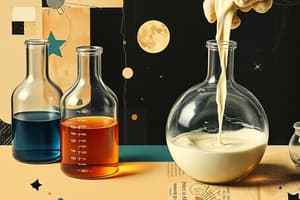Podcast
Questions and Answers
According to Newton's First Law of Motion, what will happen to an object in motion if no net force acts on it?
According to Newton's First Law of Motion, what will happen to an object in motion if no net force acts on it?
- It will gradually slow down and stop.
- It will change direction.
- It will increase its speed indefinitely.
- It will remain in motion at a constant velocity. (correct)
Which of the following statements about energy is correct?
Which of the following statements about energy is correct?
- Potential energy is independent of position.
- Kinetic energy increases with a decrease in mass.
- Energy can only be transformed from one form to another. (correct)
- Energy can be created and destroyed in certain scenarios.
Which of the following statements about waves is true?
Which of the following statements about waves is true?
- Only mechanical waves can transfer energy.
- Electromagnetic waves can propagate in a vacuum. (correct)
- The speed of waves is independent of the medium.
- All waves require a medium to travel.
What does the Second Law of Thermodynamics state about heat transfer?
What does the Second Law of Thermodynamics state about heat transfer?
How is kinetic energy calculated?
How is kinetic energy calculated?
What is the first step in the scientific method?
What is the first step in the scientific method?
Which type of chemical bond is formed by the transfer of electrons?
Which type of chemical bond is formed by the transfer of electrons?
In cell theory, which statement is correct?
In cell theory, which statement is correct?
What is the primary function of DNA?
What is the primary function of DNA?
What does natural selection primarily explain?
What does natural selection primarily explain?
Which statement correctly describes solids in terms of states of matter?
Which statement correctly describes solids in terms of states of matter?
In a chemical reaction, what are the substances called that undergo the reaction?
In a chemical reaction, what are the substances called that undergo the reaction?
What is the principle of conservation of mass in chemical reactions?
What is the principle of conservation of mass in chemical reactions?
Flashcards are hidden until you start studying
Study Notes
Scientific Method
- Definition: A systematic approach to inquiry and experimentation.
- Steps:
- Observation: Gather information through senses or instruments.
- Question: Formulate a question based on observations.
- Hypothesis: Propose an explanation or prediction that can be tested.
- Experiment: Design and conduct experiments to test the hypothesis.
- Analysis: Analyze data from experiments to draw conclusions.
- Conclusion: Determine if the hypothesis is supported or refuted.
- Communication: Share results with the scientific community.
Basic Chemistry
- Atoms and Molecules:
- Atoms: Basic unit of matter, composed of protons, neutrons, and electrons.
- Molecules: Two or more atoms bonded together.
- Chemical Bonds:
- Ionic Bonds: Transfer of electrons between atoms, forming charged ions.
- Covalent Bonds: Sharing of electron pairs between atoms.
- States of Matter:
- Solids: Fixed shape and volume.
- Liquids: Fixed volume, shape takes that of the container.
- Gases: No fixed shape or volume, expands to fill the container.
- Chemical Reactions:
- Reactants: Substances that undergo a reaction.
- Products: Substances formed from the reaction.
- Conservation of Mass: Mass is conserved in chemical reactions.
Biology Fundamentals
- Cell Theory:
- All living organisms are composed of cells.
- The cell is the basic unit of life.
- All cells arise from pre-existing cells.
- Genetics:
- DNA: Carrier of genetic information; composed of nucleotides.
- Genes: Segments of DNA that code for proteins.
- Inheritance: Traits are passed from parents to offspring through genes.
- Evolution:
- Natural Selection: Mechanism by which species adapt and evolve.
- Adaptation: Traits that enhance survival and reproduction.
- Ecology:
- Ecosystem: Interactions between organisms and their environment.
- Food Chains/Webs: Energy flow from producers to consumers.
Physics Principles
- Motion:
- Newton's Laws of Motion:
- An object at rest stays at rest; an object in motion stays in motion unless acted upon by a net force.
- Force equals mass times acceleration (F=ma).
- For every action, there is an equal and opposite reaction.
- Newton's Laws of Motion:
- Energy:
- Kinetic Energy: Energy of motion, calculated as 1/2mv².
- Potential Energy: Stored energy based on position or configuration.
- Conservation of Energy: Energy cannot be created or destroyed, only transformed.
- Waves:
- Types: Mechanical (require a medium) and Electromagnetic (do not require a medium).
- Properties: Wavelength, frequency, amplitude; speed of waves depends on the medium.
- Thermodynamics:
- First Law: Energy cannot be created or destroyed, only transformed.
- Second Law: Heat naturally flows from hot to cold; entropy increases.
Scientific Method
- Systematic approach for exploring and understanding phenomena.
- Steps:
- Observation: Engage senses or instruments for information gathering.
- Question: Develop inquiries based on observations made.
- Hypothesis: Formulate testable explanations or predictions.
- Experiment: Conduct structured tests to evaluate the hypothesis.
- Analysis: Examine experiment data to form conclusions.
- Conclusion: Assess whether the hypothesis is validated or disproven.
- Communication: Disseminate findings to the scientific community.
Basic Chemistry
- Atoms and Molecules:
- Atoms are fundamental units made up of protons, neutrons, and electrons.
- Molecules consist of two or more atoms bonded together.
- Chemical Bonds:
- Ionic Bonds involve electron transfer between atoms creating charged ions.
- Covalent Bonds are formed by sharing pairs of electrons between atoms.
- States of Matter:
- Solids maintain a fixed shape and volume.
- Liquids have a fixed volume but adapt to the shape of their container.
- Gases lack fixed shape or volume, expanding to occupy their container fully.
- Chemical Reactions:
- Reactants are the initial substances that undergo chemical changes.
- Products are substances produced from the reactions.
- The Law of Conservation of Mass asserts that mass remains unchanged in reactions.
Biology Fundamentals
- Cell Theory:
- All life forms consist of cells; cells are the basic structural unit of life.
- All cells originate from existing cells.
- Genetics:
- DNA serves as the genetic information carrier, comprising nucleotides.
- Genes are DNA segments that dictate protein synthesis.
- Inheritance ensures traits are passed from parents to offspring.
- Evolution:
- Natural Selection drives species adaptation and evolution processes.
- Adaptation refers to traits that improve survival and reproductive success.
- Ecology:
- Ecosystems include interactions among organisms and their environments.
- Food chains and webs depict the energy transfer from producers to consumers.
Physics Principles
- Motion:
- Newton's Laws of Motion outline object behavior and force interactions.
- The second law describes the relationship of force, mass, and acceleration (F=ma).
- The third law highlights the principle of action-reaction.
- Energy:
- Kinetic Energy refers to energy in motion, calculated as 1/2mv².
- Potential Energy represents stored energy based on an object's position.
- The Law of Conservation of Energy establishes that energy changes forms but is never lost.
- Waves:
- Mechanical Waves require a medium for transmission, while Electromagnetic Waves do not.
- Wave properties include wavelength, frequency, and amplitude; speed varies with the medium.
- Thermodynamics:
- The First Law indicates energy transformations, emphasizing energy conservation.
- The Second Law states that heat flows from hot to cold, leading to increased entropy.
Studying That Suits You
Use AI to generate personalized quizzes and flashcards to suit your learning preferences.




